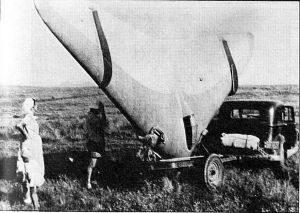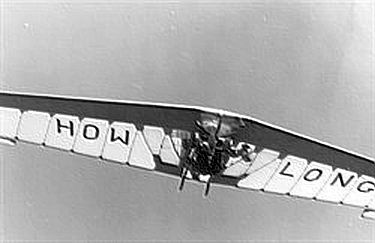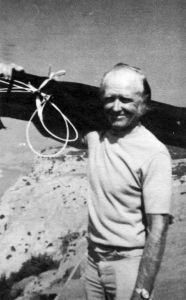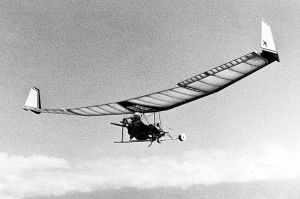Home (contents) → Miscellaneous → Mitchell Wing
Mitchell Wing
The images on this page are mostly artistic derivations of contemporary photos. See Copyright of early hang gliding photos.

While this web site generally refrains from detailing the many experimental designs that were never manufactured in significant numbers, the Mitchell Wing B-10 Buzzard is notable for its high profile among hang glider pilots and the distance world records it attained.
Like the earlier Icarus 2 and 5 (see under School for perfection in Hang gliding 1973 part 2) and the VJ-23 and VJ-24 (see VJ day — Volmer Jensen’s hang gliders) the Mitchell Wing was a rigid hang glider that required either a trailer to transport it or a carefully constructed vehicle roof rack.

Like the Icarus 5, it was a tail-less monoplane, as is also the case with most flex-wing (Rogallo) hang gliders. Unlike the Icarus 5, the Mitchell Wing was ‘cantilevered’; its structural strength was built inside the wing rather than relying on external struts and cables.
The Mitchell Wing’s origins pre-date World War 2…
Amerikabomber

The Horten H.XVIII flying wing long range Amerikabomber, which Nazi Germany planned to use to bomb the USA in World War 2, was designed by the Horten brothers, who were experienced in the construction of tail-less gliders during the government-funded boom in gliding in Germany between the two world wars. (See also the World War 2 related topics menu.) It led to four notable derivatives.

The first was the Northrop B-49 flying wing long range bomber of 1947, created by American aeronautical engineers using data captured from the Germans at the end of the war. It never went into production, but its flight testing garnered much further data concerning the performance, control, and stability of tail-less aircraft. (Edwards Air Force base is named after a pilot killed in the crash of one of the prototypes.)

The second offspring of the Amerikabomber, or perhaps more accurately of the whole experience of Reimar Horten, was the Alita tail-less rigid hang glider of the 1950s. See Horten in Earliest hang gliders for more about it.
Before World War 2, Don Mitchell built and flew his own gliders (sailplanes) and during the war he was in charge of manufacturing Waco CG-4A troop-carrying gliders(9). He gained his initial experience of ‘flying wing’ design while working for Northrop. When he met Howard Long, a medical doctor fascinated by the hang gliders of the early 1970s in California(2) the third offspring of the Amerikabomber, the Mitchell Wing hang glider, was begun. The Mitchell Wing was also known as the Buzzard or the B-10. (The latter designation perhaps acknowledged its bomber heritage.)
Don became interested in aviation when, at the age of 5, he saw the dirigible, R-34 fly over the family country home in Scotland.
— Richard Avalon (9)
Notice the resemblance of the Horten Alita, with its bubble canopy, to the first prototype Mitchell Wing, flown by Howard Long in the film under External links later on this page. It also resembles the Klingberg Wing, a prototype designed and built by Rollin Klingberg in the early 1980s.
The airfoils at these low speeds do not perform as predicted in the data.
— Don Mitchell (3)
B-10 Buzzard

Sporting a 34 foot span, the 132ft2, cantilevered wing was built of spruce and doped fabric covering in the classic wood aircraft construction style that Mitchell knew so well.
— Chuck Rhodes (2)
Although the Mitchell Wing was made largely of wood, with a hang cage made of chrome-molybdenum steel, it weighed only 75 lb. (2, 5, 10)

Production Mitchell Wings did not match the high performance of Howard Long’s glider, where he was mostly enclosed by the wing and bubble canopy — a significant streamlining(5). However, production glider hang cages provided more ground clearance of the wing during launch and landing, as well as greater all-round visibility for the pilot. Incidentally, in the film clip on YouTube (under External links) the Howard Long Mitchell Wing sequence is followed by a VJ-23, then Steve Patmont in a shiny dark blue and green Icarus II biplane. Patmont taught Howard Long to fly an Icarus II as practice for the Mitchell Wing, which Patmont also flew on an early test.
Any foot-launched hang glider was eligible for the meet, and some strange crafts appeared, including the startling new Mitchell Wing, which looked very much like pictures of some WWII prototype bombers…
— W.A. ‘Pork’ Roecker writing in Ground Skimmer, May 1976


The Mitchell Wing was unusual in that it had two sets of control mechanisms both for turn and speed control. Speed (pitch) control could be by weight shift or elevons (acting together as elevators) via a control stick. Turn control was also effected by elevons (acting differentially as ailerons) and either spoilers or rudders. (Early models had spoilers rather than rudders.) Pilots learned to fly it without using the stick, which protruded from the underside of the wing above and forward of the pilot’s head. For those training flights the stick was secured with a bungee, which was normal during launch anyway. The new Mitchell Wing pilot used just the rudders, actuated by a twist grip, for turn control, and weight shift for pitch control.
The stick is locked by a bungee chord to the right hand tube so that the elevons are in approximately a 15º up position.
— Chuck Rhodes (5)

The mechanism of the control stick is visible in this image. It is attached to the aft face of the leading edge D-spar just right of the center. Unlike sticks in most aircraft, including gliders, it protrudes downwards to where the pilot can hold it.
The rudder twist grip — there was only one — was on the forward left hang cage tube. Twisting it left activated the left rudder and right for the right rudder. Pulling it back deployed both rudders simultaneously to increase drag, such as when a steeper glide is needed on landing approach. (5)
George Worthington, a former US Navy pilot, bought the third production Mitchell wing and he persuaded Don Mitchell to replace the spoilers with rudders. That change, when implemented on Worthington’s and all subsequent wings, resulted in improved handling and performance. Those with spoilers were all destroyed in crashes. (7)
Even with the improved control afforded by the rudders, the Mitchell Wing, like any hang glider, needed its pilot to fly with due care and attention.
The wing can enter a stall/spin if you are not careful in a slow turn and you stall the inboard wing. This can happen if you get your weight to far back in the hang cage and aft of the CG.
— Chuck Rhodes (8)

Worthington became a world distance record-holding hang glider pilot in his fifties and sixties flying a Mitchell Wing as well as flying flex-wing hang gliders in the Owens valley. Chuck Rhodes (pictured) having started on standard Rogallos in 1974, bought Worthington’s glider in April 1982. (2)

Among flying machines as a whole, rigid hang gliders’ control systems are simple, although not as simple as those of flex-wings, which have essentially no moving parts. Nonetheless, in the rough-and-tumble environment of windy and hot — or sometimes cold — mountainsides and hill sides where hang gliders are rigged and launched, even simple control mechanisms with moving parts arguably present an additional risk factor. For example, a Fledgling ‘semi-rigid’ wing pilot in Britain was killed when he launched with his tip rudder control cables disconnected(14). More recently the pilot of an Icaro Stratos had a spoiler activation cable caught on a rib and he crashed into trees, sustaining minor injuries(15). George Worthington’s considerable airplane and glider (sailplane) flying experience undoubtedly caused him to favor the Mitchell Wing because of its redundant control systems.
George Worthington lost rudder control while flying his M-Wing at Torrey Pines when one of his rudder control cables became too slack after a glue block holding the cable housing in place failed. He resorted to using the elevons and weight shift…
— Chuck Rhodes (5)
Despite the visual impressiveness of the Mitchell wing and George Worthington’s world records flying it, only a handful of Mitchell Wings ever flew as hang gliders. Many more were built as powered ultralights: At one ‘Ultralight Fly-In’ at Porterfield, more than 400 powered B-10s came from all over the United States and Canada. (9)
I built 7 complete “Mitchell Wings” and turned out 5 more kits.
— Don Mitchell (9)
To accord those numbers some perspective, the USA’s premier specialty hang glider manufacturer catering to pilots demanding a hand-built state-of-the art wing, Seedwings of Santa Barbara, made about 160 gliders in 1984(4). At the other extreme, La Mouette in France made 1,800 gliders in 1987. (6)

The prototype Mitchell Wing was destroyed when a rock that Howard Long did not see when launching caught a tip and the wing ‘cartwheeled’, breaking both main spars. Howard did not repair it. (2)

This photo, reprinted courtesy Light Sport and Ultralight Flying magazine, shows the profile of the Mitchell wing with its dihedral outer segments. It shows also the control stick, for the elevons, protruding from the underside of the wing ahead of the pilot. This one has no tip rudders. (See also Early powered ultralights part 1.)
By 1980 when Worthington set his last record with the wing, he was the only one in the world flying a Mitchell Wing as a hang glider.
— Chuck Rhodes (2)

George Worthington was killed in 1982 when an experimental powered ultralight he was flying, the Wanderer, broke up. (The Wanderer was designed by radio control glider champion Mark Smith. See Hang gliding 1973 part 1 for Smith’s first experimental hang glider.) It seems likely to me (the original author of this web site) that Worthington had suffered a minor stroke the previous night, judging by reports from those with him on that last day. (12)
Don Mitchell died in 1993 at age 78. (11)
Like Worthington before him, Chuck Rhodes was also in the navy, eventually rising to captain rank, which left him with less time for hang gliding than he would have liked. In 2006 Rhodes donated the Mitchell Wing (Worthington’s record-setting wing) to the Experimental Aircraft Association museum in Oshkosh, Wisconsin(1). He spends his retirement building and operating wind-powered watercraft. (13)
American bomber

The fourth offspring of the Amerikabomber, more accurately its grandchild because it drew on the Northrop B-49 research, is the Northrop-Grumman B-2 Spirit ‘stealth’ bomber. It holds records for the longest ever bombing missions; from Whiteman AFB, Missouri, to Kosovo in 1999 and to Afghanistan in 2001, returning home to Whiteman non-stop in both cases. I assume some of this might still be classified, but it should be no surprise that the chief aerodynamicist on the B-2 began as a hang glider designer in the mid 1970s while at college. It was his knowledge and experience of designing, flying, and — at least as importantly — manufacturing hang gliders that secured him the job. See Spectra Aolus for more about that, especially the last paragraph.
External links
End of a Legend by Rick Masters about George Worthington’s last flight (and the same on the US Hawks forum)
Horten Ho. 229 – Hitler’s UFO by Mark Felton Productions on YouTube
Howard Long in the prototype Mitchell Wing: Hang Ten Hang Gliding World Meet, Part 1 in 1976 on the Steve Morris YouTube channel, starting at 5 minutes 43 seconds. It provides two camera points of view, the first cameraman having to roll on the ground to prevent being struck by the Mitchell Wing’s left leading edge.
References
1. Chuck Rhodes, Navy Medicine, Vol. 96, No. 1, January-February 2005
2. Chuck Rhodes, Mitchell Wing Legacy in Whole Air, January 1985
3. Don Mitchell, Design & Development of the Mitchell Wing in Hang Gliding, January 1978
4. Dan Johnson, Product Lines in Whole Air, January 1985
5. Chuck Rhodes, Mitchell Wing Legacy part 2 in Whole Air, March 1985
6. Dan Johnson writing in Hang Gliding, July 1988
7. George Worthington, In Search of World Records, 1980
8. Chuck Rhodes writing in in the U.S. Hang Gliding Digest in November, 1998, retrieved in August 2020 from Mitchell Wing by U.S. Pacific on Nest of Dragons
9. The life and Times of Don S. Mitchell by Richard Avalon, 1990, on Twitt.org
10. Chuck Rhodes, Mitchell Wing Madness in Hang Gliding, January 1983
11. Don Mitchell (aircraft designer) on Wikipedia
12. The End of a Legend: George Worthington’s Last Ride by Rick Masters in Glider Rider, November 1982. Available in 1982 under Dangerous Thoughts by Rick Masters on US Hawks.
13. Chuck’s Sea, Wind, Sky Chronicles: Chuck Rhodes’ blog
14. Glider Rider, May 1978
15. BHPA accident and incident digest, SkyWings, September 2020
Interesting stuff Everard…. as always..
Keep it up..
LikeLike
Interesting to read about the evolution of the control system. My instructor Mike McCarron built a Mitchell and I witnessed his maiden flight with it. He intentionally had not tied off the control stick ( although he knew of that recommendation for early flights ). He launched and stabilized at about 30ft up and then his weight shift habits caused him to push on the control stick as he intended to slide his weight aft. He entered an alarmingly steep dive and held it until plowing into the turf. He lay there unmoving for a long time but was not hurt. He sold the glider shortly thereafter. I suspect he might of been a data point influencing the design changes.
LikeLike